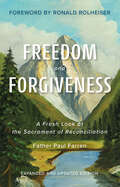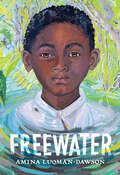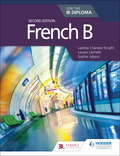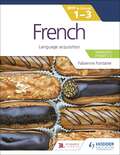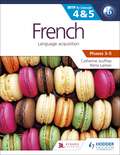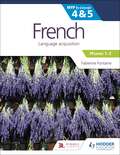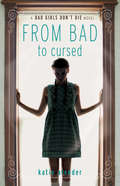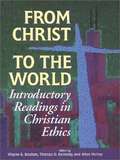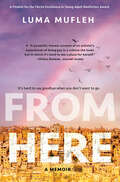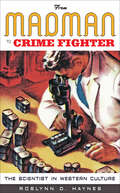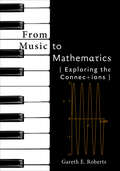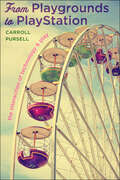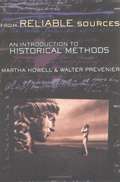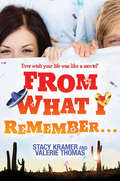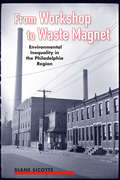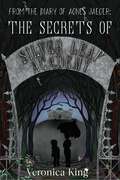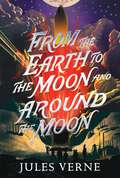- Table View
- List View
Freedom and Forgiveness: A Fresh Look at the Sacrament of Reconciliation
by Paul FarrenBe enveloped in the gentle and tender embrace of a loving God who longs for a restored relationship with his children.What does confession mean? Why do I need forgiveness? How can I reconcile a broken relationship? Whoever thought that confession could be about God confessing his love for us? In confession we are reconnected to the voice of God in our soul who whispers -- Do not be afraid. I have redeemed you. I have called you by your name. You are mine. You are precious in my eyes. Misplaced guilt and shame paralyze individuals, causing division, bitterness, and blame. God's love transforms our lives and affects our relationships with others. Father Farren's Irish storytelling background comes to the forefront as he writes simply but effectively, opening the door for people to be free to confess their need for God and experience his limitless forgiveness. Explore life-changing biblical insights about sin, confession, forgiveness, and reconciliation. Freedom and Forgiveness outlines God's true nature, explores spiritual graces, and promotes spiritual healing found in the sacrament of Reconciliation. "We all need God's mercy. Our God is unimaginable in patience and mercy. There is no limit to God's patience. There is nothing that can ever exhaust the divine well. It's never too late! This wonderful book on reconciliation helps keep us aware of that."— Ronald Rolheiser
Freewater
by Amina Luqman-DawsonWinner of the John Newbery Medal Winner of the Coretta Scott King Author Award Award-winning author Amina Luqman-Dawson pens a lyrical, accessible historical middle-grade novel about two enslaved children&’s escape from a plantation and the many ways they find freedom. After an entire young life of enslavement, twelve-year-old Homer escapes Southerland Plantation with his little sister Ada, leaving his beloved mother behind. Much as he adores her and fears for her life, Homer knows there&’s no turning back, not with the overseer on their trail. Through tangled vines, secret doorways, and over a sky bridge, the two find a secret community called Freewater, deep in the recesses of the swamp. In this new, free society made up of escaped slaves and some born-free children, Homer cautiously embraces a set of spirited friends, almost forgetting where he came from. But when he learns of a threat that could destroy Freewater, he hatches a plan to return to Southerland plantation, overcome his own cautious nature, and free his mother from enslavement. Loosely based on a little-mined but important piece of history, this is an inspiring and deeply empowering story of survival, love, and courage.
French B for the IB Diploma Second edition
by Lauren Léchelle Sophie Jobson Laetitia Chanéac-KnightExam board: International BaccalaureateLevel: IB DiplomaSubject: FrenchFirst teaching: September 2018First exams: Summer 2020Develop competent communicators who can demonstrate a sound conceptual understanding of the language with a flexible course that ensures thorough coverage of the updated French B Guide and is designed to meet the needs of all IB students at Standard and Higher Level.- Empower students to communicate confidently by exploring the five prescribed themes through authentic texts and skills practice at the right level, delivered in clear learning pathways. - Ensure students are able to produce coherent written texts and deliver proficient presentations with grammar and vocabulary introduced in context and in relation to appropriate spoken and written registers. - Improve receptive skills with authentic written texts, audio recordings spoken at a natural pace, and carefully crafted reading and listening tasks.- Promote global citizenship, intercultural understanding and an appreciation of Francophone cultures through a wide range of text types and cultural material from around the world. - Deliver effective practice with a range of structured tasks within each unit that build reading, listening, speaking and writing skills.- Establish meaningful links to TOK and CAS, and identify learner profile attributes in action.The audio for the Student Book is FREE to download from www.hoddereducation.com/ibextras
French for the IB MYP 1-3 (Emergent/Phases 1-2) (Emergent/Phases 1-2) (Emergent/Phases 1-2) (Emergent/Phases 1-2): MYP by Concept: Language acquisition
by Fabienne FontaineDevelop your skills to become an inquiring learner; ensure you navigate the MYP framework with confidence using a concept-driven and assessment-focused approach to French, presented in global contexts.- Develop conceptual understanding with key MYP concepts and related concepts at the heart of each chapter.- Learn by asking questions for a statement of inquiry in each chapter.- Prepare for every aspect of assessment using support and tasks designed by experienced educators.- Understand how to extend your learning through research projects and interdisciplinary opportunities.- Think internationally with chapters and concepts set in global contexts.Contents1 Et si on apprenait une nouvelle langue ?2 Qui sont vos proches ?3 Où te sens-tu chez toi?4 Quel est le programme aujourd'hui ?5 Quels sont tes loisirs ?6 Aimes-tu les fêtes et les traditions ?7 Prends-tu soin de toi ?8 Tu as dit shopping ?9 La technologie, peut-elle communiquer pour nous ?10 Comment voyages-tu ?11 Que fais-tu pour ta communauté ?12 Désirons-nous véritablement protéger notre environnement ?
French for the IB MYP 4 & 5: By Concept (MYP By Concept)
by Catherine Jouffrey Rémy LamonThe only series for MYP 4 and 5 developed exclusively with the IBDrive meaningful inquiry through a unique concept-driven narrative.- Supports every aspect of assessment with opportunities that use the criteria- Gives you easy ways to differentiate and extend learning- Provides a meaningful approach by integrating the inquiry statement in a global context- Develops critical-thinking skills with activities and summative sections rooted in the ATL frameworkThis title is also available in two digital formats via Dynamic Learning. Find out more by clicking on the links at the top of the page.
French for the IB MYP 4&5 (Phases 1-2): by Concept
by Fabienne FontaineDevelop your skills to become an inquiring learner; ensure you navigate the MYP framework with confidence using a concept-driven and assessment-focused approach to French, presented in global contexts.- Develop conceptual understanding with key MYP concepts and related concepts at the heart of each chapter. - Learn by asking questions for a statement of inquiry in each chapter. - Prepare for every aspect of assessment using support and tasks designed by experienced educators.- Understand how to extend your learning through research projects and interdisciplinary opportunities.- Think internationally with chapters and concepts set in global contexts.
Fresh Air: The Holy Spirit for an Inspired Life
by Jack Levison"Fresh Air offers careful examination of the Holy Spirit, all tangled up with a wide wonder."—Nichole Nordeman "I've often asked pastors, 'Who is the most neglected person of the Trinity?' They always answer, 'The Holy Spirit.' In this lively and—well—Spirit-filled book, Jack Levison enjoys the exploits of the Holy Spirit throughout scripture, provoking a fresh encounter with God. Jack is uniquely qualified to lead us, combining his scholarly understanding of scripture with his deep affection for the church, both mainline and Pentecostal. No one will think about the Holy Spirit in the same way after reading Jack's book." —Will Willimon "Jack Levison's book is the most biblical, wide-ranging, innovative, and refreshing book on the Holy Spirit in years. The Spirit is here de-programmed and set loose. You may be surprised in every chapter, I know I was." —Scot McKnight "Fresh Air is, well, a breath of fresh air. Jack Levison fuses an accurate but unpretentious examination of the Holy Spirit in Scripture with a lively and generous style that invites the entire Christian community, regardless of label, to embrace God's Spirit in the everyday ordinariness of life." —Eugene Peterson "FRESH AIR is exactly what its title promises: a lively, fresh study of the theology of the Holy Spirit by a brilliant and spirited theologian. If there is such a thing as poignant Christian midrash, then this surely is it." —Phyllis Tickle "People told me Jack Levison was a great teacher, and when I read this book I realized why. His excitement is infectious; he tells a great story; he sets little-known biblical passages on fire and drills down to unimagined depths in well-known ones. He has a boyish enthusiasm, but his account of the holy spirit – and what the spirit can do for whole churches, not just individuals! – is mature, seasoned, challenging and wise. His scholarship is spot on, his human warmth and Christian compassion are everywhere. An unbeatable combination." —N. T. Wright
Friendship Never Ends
by Ella DysonA big-hearted comedy about friendship, the 90s and the greatest girl band in the world Three independent women - and one man who lives for drama - haven't spoken to their best friend in 20 years, after an epic talent show disaster tore them apart during the height of Spice-mania.Self-appointed gang leader Carmen then decided to go it alone - Geri style. But now, in 2018, the school reunion is fast approaching. Friendship Never Ends tells the story of Carmen's plan to win back her former besties - Jemma, Ellie, Laura and Benny - ahead of the big night. But has Carmen really changed? And can their friendship ever really go back to how it was?
From A Dark Place: How A Family Coped With Drug Addiction
by Paul Husband Tony HusbandWhen the Husband family realised that their son Paul was addicted to heroin, they did everything they could to help him but it seemed that every step in the right direction would be followed by another relapse as Paul lied to them, stole from them, and come close to losing his life.This illustrated title from award-winning cartoonist Tony Husband tells the tale of those dark days as they worked as a family to get Paul into the right sort of supportive environment where he could truly recover from his dangerous addiction, and move from that dark place to a brighter future.This inspiring and compelling story will appeal to anyone who has struggled with an addictive disorder, or any families or friends who have had to support someone through such a situation. Anyone who was touched by Tony's Take Care, Son - The Story of my Dad and His Dementia will be similarly moved and uplifted by From A Dark Place.
From Bad to Cursed (Bad Girls Don't Die #2)
by Katie AlenderAlexis is the last girl you'd expect to sell her soul. She already has everything she needs--an adorable boyfriend, the perfect best friend, and a little sister who's finally recovering after being possessed by an evil spirit, then institutionalized. Alexis is thrilled when her sister joins a club; new friends are just what Kasey needs. It's strange, though, to see how fast the girls in The Sunshine Club go from dorky and antisocial to gorgeous and popular.
From Christ to the World: Introductory Readings in Christian Ethics
by Wayne G. Boulton Thomas D. Kennedy Allen VerheyThis is a single volume that effectively introduces students to the full breadth of the discipline of Christian ethics. This reader captures the range of timely issues related to ethics but not at the expense of essays that show the theoretical foundations of the field. Part One examines the sources of Christian EthicsScripture, tradition, philosophy, and science. The norms, forms, and contexts of Christian moral theories are reviewed in Part Two. The final section discusses contemporary questions about human sexuality, medical practice, the use of force, economic justice, ecological responsibility, and more. Relevant biblical readings and a series of case studies accentuate the text. "
From Here
by Luma MuflehIn her coming-of-age memoir, refugee advocate Luma Mufleh writes of her tumultuous journey to reconcile her identity as a gay Muslim woman and a proud Arab-turned-American refugee.With no word for &“gay&” in Arabic, Luma may not have known what to call the feelings she had growing up in Jordan during the 1980s, but she knew well enough to keep them secret. It was clear that not only would her family have trouble accepting her, but trapped in a conservative religious society, she could&’ve also been killed if anyone discovered her sexuality. Luma spent her teenage years increasingly desperate to find a way out, and finally found one when she was accepted into college in the United States. Once there, Luma begins the agonizing process of applying for political asylum, which ensures her safety—but causes her family to break ties with her.Becoming a refugee in America is a rude awakening, and Luma must rely on the grace of friends and strangers alike as she builds a new life and finally embraces her full self. Slowly, she&’s able to forge a new path forward with both her biological and chosen families, eventually founding Fugees Family, a nonprofit dedicated to the education and support of refugee children in the United States.As hopeful as it is heartrending, From Here is a coming-of-age memoir about one young woman&’s search for belonging and the many meanings of home for those who must leave theirs.
From Little Tokyo, with Love
by Sarah KuhnOne of PEOPLE Magazine's Best Books of Summer! "I absolutely adored this funny, fierce, big-hearted book.&” —Morgan Matson, New York Times bestselling author of Save the Date Celebrated author Sarah Kuhn reinvents the modern fairy tale in this intensely personal yet hilarious novel of a girl whose search for a storybook ending takes her to unexpected places in both her beloved LA neighborhood and her own guarded heart.If Rika's life seems like the beginning of a familiar fairy tale—being an orphan with two bossy cousins and working away in her aunts' business—she would be the first to reject that foolish notion. After all, she loves her family (even if her cousins were named after Disney characters), and with her biracial background, amazing judo skills and red-hot temper, she doesn't quite fit the princess mold. All that changes the instant she locks eyes with Grace Kimura, America's reigning rom-com sweetheart, during the Nikkei Week Festival. From there, Rika embarks on a madcap adventure of hope and happiness—searching for clues that Grace is her long-lost mother, exploring Little Tokyo's hidden treasures with cute actor Hank Chen, and maybe . . . finally finding a sense of belonging.But fairy tales are fiction and the real world isn't so kind. Rika knows she's setting herself up for disappointment, because happy endings don't happen to girls like her. Should she walk away before she gets in even deeper, or let herself be swept away?
From Madman to Crime Fighter: The Scientist in Western Culture
by Roslynn D. HaynesThe story of the scientist in Western culture, from medieval images of alchemists to present-day depictions of cyberpunks and genetic engineers.They were mad, of course. Or evil. Or godless, amoral, arrogant, impersonal, and inhuman. At best, they were well intentioned but blind to the dangers of forces they barely controlled. They were Faust and Frankenstein, Jekyll and Moreau, Caligari and Strangelove—the scientists of film and fiction, cultural archetypes that reflected ancient fears of tampering with the unknown or unleashing the little-understood powers of nature.In From Madman to Crime Fighter, Roslynn D. Haynes analyzes stereotypical characters—including the mad scientist, the cold-blooded pursuer of knowledge, the intrepid pathbreaker, and the bumbling fool—that, from medieval times to the present day, have been used to depict the scientist in Western literature and film. She also describes more realistically drawn scientists, characters who are conscious of their public responsibility to expose dangers from pollution and climate change yet fearful of being accused of lacking evidence.Drawing on examples from Britain, America, Germany, France, Russia, and elsewhere, Haynes explores the persistent folklore of mad doctors of science and its relation to popular fears of a depersonalized, male-dominated, and socially irresponsible pursuit of knowledge for its own sake. She concludes that today’s public response to science and scientists—much of it negative—is best understood by recognizing the importance of such cultural archetypes and their significance as myth. From Madman to Crime Fighter is the most comprehensive study of the image of the scientist in Western literature and film.
From Me to You: A Lonely Hearts Club Short Story
by Elizabeth EulbergCan't wait to read We Can Work It Out? Return to the world of Penny Lane Bloom with three all new e-book short stories that pick up right where The Lonely Hearts Club left off!Four months ago, Penny Lane Bloom was heartbroken over a guy, had only a small handful of close friends, and was sure that, somehow, this year was going to be different.Four months later, everything has changed. Penny's gone from a few friends to a huge group of girls who all have each other's backs, from a guy who thought nothing of cheating to a total sweetheart, and from the idea for The Lonely Hearts Club to a full-scale girls-rock revolution. Just think how much more she'll be able to accomplish by the end of the school year! And it's the holidays, which means Penny has two blissful weeks to spend eating cheese fries with her girls and kissing Ryan. The only thing she still has to do is survive Christmas with her family.Don't miss all three e-shorts from romantic comedy superstar Elizabeth Eulberg. Each one contains a sneak peek at an excerpt from her return to the world of the LHC, We Can Work It Out!
From Mesopotamia to Iraq: A Concise History
by Hans J. Nissen Peter HeineA sweeping account of the rich history that has played out between these chronological poles, From Mesopotamia to Iraq looks back through 10,000 years of the regions deeply significant yet increasingly overshadowed past.
From Music to Mathematics: Exploring the Connections
by Gareth E. RobertsA guided tour of the mathematical principles inherent in music.Taking a "music first" approach, Gareth E. Roberts's From Music to Mathematics will inspire students to learn important, interesting, and at times advanced mathematics. Ranging from a discussion of the geometric sequences and series found in the rhythmic structure of music to the phase-shifting techniques of composer Steve Reich, the musical concepts and examples in the book motivate a deeper study of mathematics.Comprehensive and clearly written, From Music to Mathematics is designed to appeal to readers without specialized knowledge of mathematics or music. Students are taught the relevant concepts from music theory (notation, scales, intervals, the circle of fifths, tonality, etc.), with the pertinent mathematics developed alongside the related musical topic. The mathematics advances in level of difficulty from calculating with fractions, to manipulating trigonometric formulas, to constructing group multiplication tables and proving a number is irrational. Topics discussed in the book include• Rhythm • Introductory music theory • The science of sound • Tuning and temperament• Symmetry in music • The Bartók controversy • Change ringing • Twelve-tone music• Mathematical modern music • The Hemachandra–Fibonacci numbers and the golden ratio• Magic squares • Phase shiftingFeaturing numerous musical excerpts, including several from jazz and popular music, each topic is presented in a clear and in-depth fashion. Sample problems are included as part of the exposition, with carefully written solutions provided to assist the reader. The book also contains more than 200 exercises designed to help develop students' analytical skills and reinforce the material in the text. From the first chapter through the last, readers eager to learn more about the connections between mathematics and music will find a comprehensive textbook designed to satisfy their natural curiosity.
From Playgrounds to PlayStation: The Interaction of Technology and Play
by Carroll PursellHow technology shapes play in America—and vice versa.In this romp through the changing landscape of nineteenth- and twentieth-century American toys, games, hobbies, and amusements, senior historian of technology Carroll Pursell poses a simple but interesting question: What can we learn by studying the relationship between technology and play? From Playgrounds to PlayStation explores how play reflects and drives the evolution of American culture. Pursell engagingly examines the ways in which technology affects play and play shapes people. The objects that children (and adults) play with and play on, along with their games and the hobbies they pursue, can reinforce but also challenge gender roles and cultural norms. Inventors—who often talk about "playing" at their work, as if motivated by the pure fun of invention—have used new materials and technologies to reshape sports and gameplay, sometimes even crafting new, extreme forms of recreation, but always responding to popular demand.Drawing from a range of sources, including scholarly monographs, patent records, newspapers, and popular and technical journals, the book covers numerous modes and sites of play. Pursell touches on the safety-conscious playground reform movement, the dazzling mechanical innovations that gave rise to commercial amusement parks, and the media's colorful promotion of toys, pastimes, and sporting events. Along the way, he shows readers how technology enables the forms, equipment, and devices of play to evolve constantly, both reflecting consumer choices and driving innovators and manufacturers to promote toys that involve entirely new kinds of play—from LEGOs and skateboards to beading kits and videogames.
From Reliable Sources: An Introduction to Historical Methods
by Martha C. Howell Walter PrevenierFrom Reliable Sources is a lively introduction to historical methodology, an overview of the techniques historians must master in order to reconstruct the past. Its focus on the basics of source criticism, rather than on how to find references or on the process of writing, makes it an invaluable guide for all students of history and for anyone who must extract meaning from written and unwritten sources. Martha Howell and Walter Prevenier explore the methods employed by historians to establish the reliability of materials; how they choose, authenticate, decode, compare, and, finally, interpret those sources. Illustrating their discussion with examples from the distant past as well as more contemporary events, they pay particular attention to recent information media, such as television, film, and videotape. The authors do not subscribe to the positivist belief that the historian can attain objective and total knowledge of the past. Instead, they argue that each generation of historians develops its own perspective, and that our understanding of the past is constantly reshaped by the historian and the world he or she inhabits. A substantially revised and updated edition of Prevenier's Uit goede bron, originally published in Belgium and now in its seventh edition, From Reliable Sources also provides a survey of western historiography and an extensive research bibliography.
From Shade to Shine: New Poems
by Jill Peláez BaumgaertnerThis collection of poems begins in the growing darkness of November, stretches through Advent and the seasons leading to Easter and to Pentecost, and ends in the budding light of the Scottish Orkney Islands, where the canonical hours measure time over centuries and where God broods over an austere and beautiful landscape. The measurement of time passing and returning, year after year, in the rhythms of the seasons and of the liturgical year, create the pace and the song. But in the biblical voices of Magdalene, Mary, Abel, and Eve, and in the grim historical and political realities of war and suffering, one also hears lament and finds the poet's clear-eyed gaze straight into life's challenges. Memory is at work here, too, in personal reminiscences and in theological reflection. As one philosopher has said, "All truth is God's truth." From Shade to Shine is published under Paraclete Press's Iron Pen imprint. In the book of Job, a suffering man pours out his anguish to his Maker. From the depths of his pain, he reveals a trust in God's goodness that is stronger than his despair, giving humanity some of the most beautiful and poetic verses of all time. Paraclete's Iron Pen imprint is inspired by this spirit of unvarnished honesty and tenacious hope.
From What I Remember...
by Valerie Thomas Stacy KramerKYLIE: Mexico? What a nightmare! I should be putting the finishing touches on my valedictorian speech. Graduation is TODAY! Wait! Is this a wedding band on my finger??MAX: It started with Kylie's laptop and a truck full of stolen electronics and it ended in Ensenada. It was hot, the way she broke us out like some chick in an action movie. But now we're stranded here, with less than twenty-four hours before graduation.WILL: Saving Kylie Flores from herself is kind of a full-time occupation. Luckily, I, Will Bixby, was born for the job. And when I found out she was stuck in Mexico with dreamy Max Langston, sure, I agreed to bring their passports across the border but there's no reason to rush back home right away. This party is just getting started.LILY: This cannot be happening. It's like some cruel joke. Or a bad dream. I close my eyes and when I reopen them, they're still there. Max and Kylie Flores, freak of the century. In bed together. If Kylie thinks I'm giving him up without a fight, she's dead wrong.
From Willa, With Love
by Coleen Murtagh ParatoreIt's a surprising, sparkling summer for Willa!It's August on Cape Cod and Willa has a lot to look forward to. Soon, JFK will return home from baseball camp, and Willa has an idea for an exciting new project that will challenge her to dream big! But life throws Willa some unexpected twists and turns: Ruby has bad news, a beloved friend leaves, a dear friend returns, her brother Will has something he does't want to talk about, and of course, there's a wedding to plan! There's also a cute boy who likes Willa . . . a lot, and Willa thinks she might like him too. It's a summer full of romance and surprises!
From Workshop to Waste Magnet: Environmental Inequality in the Philadelphia Region
by Diane SicotteLike many industrialized regions, the Philadelphia metro area contains pockets of environmental degradation: neighborhoods littered with abandoned waste sites, polluting factories, and smoke-belching incinerators. However, other neighborhoods within and around the city are relatively pristine. This eye-opening book reveals that such environmental inequalities did not occur by chance, but were instead the result of specific policy decisions that served to exacerbate endemic classism and racism. From Workshop to Waste Magnet presents Philadelphia's environmental history as a bracing case study in mismanagement and injustice. Sociologist Diane Sicotte digs deep into the city's past as a titan of American manufacturing to trace how only a few communities came to host nearly all of the area's polluting and waste disposal land uses. By examining the complex interactions among economic decline, federal regulations, local politics, and shifting ethnic demographics, she not only dissects what went wrong in Philadelphia but also identifies lessons for environmental justice activism today. Sicotte's research tallies both the environmental and social costs of industrial pollution, exposing the devastation that occurs when mass quantities of society's wastes mix with toxic levels of systemic racism and economic inequality. From Workshop to Waste Magnet is a compelling read for anyone concerned with the health of America's cities and the people who live in them.
From the Diary of Agnes Jaeger: The Secrets of Silver Leaf Academy
by Veronica KingDelve into a new dark academia tale where people go missing and secrets lurk around every corner Veronica King, whose debut was hailed as "one enchanting package."Agnes Jaeger's life is turned upside down when she must relocate to live with her estranged aunt, Sibyl, who, up until now, has only been a character in her mother's stories. Now living in a home filled with spider webs and books so old they might crumble, she is thrown into the wolves' den of upper society. As a mid-semester transfer at Ore Tree's Silver Leaf Academy, Agnes must adjust to her new circumstances that unfortunately include vicious bullies and strict customs she doesn't understand. To make matters worse, her aunt is obsessed with a secret but refuses to share, her classmates are disappearing, and inexplicable incidents keep happening. Can the rumors of a cult be true? What mysteries are hiding under the polished halls of her new school?
From the Earth to the Moon and Around the Moon (The Jules Verne Collection)
by Jules VerneGun experts set their sights on shooting a man to the moon in these two novels by Jules Verne—now available together with an arresting new look!In the aftermath of the American Civil War, the members of The Baltimore Gun Club find themselves in a dilemma—without a war, there is no demand for their innovative gun designs. Eager for a new challenge, the club&’s President Barbicane sets an ambitious goal: to build the largest gun in the world, powerful enough to shoot a man to the moon. Such a gun has never been attempted, so the club faces a myriad of challenges including what to make it from, where to build it, when to shoot it, and—most importantly—how to ensure that a passenger inside the gun&’s projectile can survive the trip. In From Earth to the Moon, the members of the gun club undertake the engineering challenge, and Around the Moon follows the three voyagers on their journey to the moon and back.
